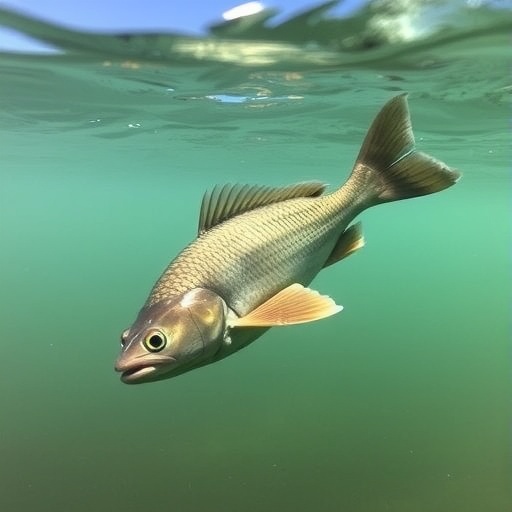In a groundbreaking study published in the journal Environmental Monitoring and Assessment, researchers delve into the intricate dynamics of two flatfish species inhabiting the Hooghly Estuary in the Bay of Bengal. The article, authored by Majhi, Khatun, Hossain, and colleagues, emphasizes the importance of length-based stock assessment in enhancing our understanding of fish populations, particularly in relation to environmental parameters. This comprehensive research sheds light on sustainable fisheries management and the ecological balance required to preserve marine biodiversity.
The Hooghly Estuary serves as a critical ecosystem, bridging both freshwater and marine environments. It supports a diverse assemblage of aquatic life, which plays a fundamental role in the ecological health of the region. The estuary’s dynamic nature makes it a hotspot for fish species such as the flatfish, which are crucial for both local fisheries and the broader marine food web. The ecological intricacies of this estuary highlight the necessity to conduct rigorous research to inform sustainable fishing practices.
The researchers employed a robust methodology to assess the fish populations in the Hooghly Estuary. They collected extensive data on the size distribution of the two flatfish species, encompassing various length categories. By analyzing length-based metrics, the study elucidates key aspects of population dynamics, such as growth rates, mortality estimates, and recruitment patterns. These factors are instrumental for formulating effective management strategies aimed at conserving fish stocks.
Understanding the interaction between flatfish populations and environmental parameters is a central focus of this research. The study meticulously examines how variations in salinity, temperature, and other ecological factors influence fish distribution and abundance. Such insights are pivotal for predicting how climate change and human activities may affect the survival of these species in the future, thereby allowing for proactive measures in fisheries management.
The findings of this extensive assessment underscore the need for policymakers and fisheries managers to adopt a science-based approach when establishing regulations and fishing quotas. The rich dataset provided by the authors serves as a foundation for future research and can guide efforts to mitigate overfishing and habitat degradation in the estuary. By understanding the life cycles and ecological requirements of these flatfish, stakeholders can foster a more sustainable interaction with marine resources.
Moreover, the research emphasizes the significance of community involvement in fisheries management. Engaging local stakeholders, including fishers, in the decision-making process can lead to improved adherence to sustainable practices. The study proposes the creation of localized management plans that incorporate traditional knowledge alongside scientific findings, ensuring that the cultural context and livelihood needs of local communities are recognized.
Furthermore, the implications of this study extend beyond the boundaries of the Hooghly Estuary. It raises broader questions about the sustainability of fisheries in estuarine environments across the globe. As coastal populations continue to grow and demand for seafood increases, it becomes increasingly imperative to adopt an integrated management approach that accounts for ecological health as well as economic viability.
As the authors elucidate, effective resource management in the context of fisheries requires a multifaceted strategy. This includes regular monitoring of fish stocks, habitat restoration efforts, and enforcement of regulations aimed at protecting vulnerable species. The study’s comprehensive framework could serve as a model for similar ecosystems, illustrating how integrating ecological research with management practices can yield beneficial outcomes.
In light of the ongoing challenges posed by overfishing and environmental degradation, this research presents a vital opportunity for the scientific community, policymakers, and the fishing industry to collaborate. By prioritizing sustainable practices informed by data-driven assessments, we can work toward protecting marine biodiversity while also securing the livelihoods of those dependent on these resources.
In conclusion, the length-based stock assessment and population dynamics of flatfish from the Hooghly Estuary offer critical insights into the interplay between ecological health and fisheries management. This study stands as a testament to the importance of scientific research in advocating for sustainable resource management practices. As we move toward an uncertain climate future, the findings from this unique estuarine ecosystem will be invaluable for ensuring that both biodiversity and human communities thrive in harmony.
The implications of this research are profound, illustrating how ecological science can directly inform and support sustainable practices in fisheries. By understanding the population dynamics and environmental correlations of flatfish, the study equips stakeholders with the knowledge necessary to safeguard marine resources. Such integrated approaches are essential in creating resilient ecosystems capable of adapting to the pressures of climate change and anthropogenic influences.
As the implications of this research unfold, it is anticipated that it will inspire further studies in other critical ecosystems. Collaborative efforts between scientists, local communities, and policymakers must be prioritized to realize the potential for sustainable fisheries management globally. Addressing these challenges head-on with a robust, scientific framework is not just beneficial; it’s imperative for the future of our oceans and the diverse life they harbor.
Thus, the discourse initiated by this study serves not just as essential academic research but as a clarion call to action for all stakeholders involved in marine resource management. By embracing a forward-thinking and inclusive approach, we can ensure that the lessons learned from the Hooghly Estuary resonate far beyond its shores, fostering a culture of sustainability in fisheries worldwide.
Subject of Research: Length-based stock assessment and population dynamics of flatfish species in the Hooghly estuary.
Article Title: Length-based stock assessment and population dynamics of two flat fishes, in relation to environmental parameters from Hooghly estuary (Bay of Bengal), India: implication for sustainable resource management.
Article References:
Majhi, B.M., Khatun, M.S., Hossain, M.Y. et al. Length-based stock assessment and population dynamics of two flat fishes, in relation to environmental parameters from Hooghly estuary (Bay of Bengal), India: implication for sustainable resource management.
Environ Monit Assess 197, 1080 (2025). https://doi.org/10.1007/s10661-025-14484-7
Image Credits: AI Generated
DOI: 10.1007/s10661-025-14484-7
Keywords: flatfish, stock assessment, population dynamics, sustainable fisheries management, Hooghly estuary, environmental parameters.




